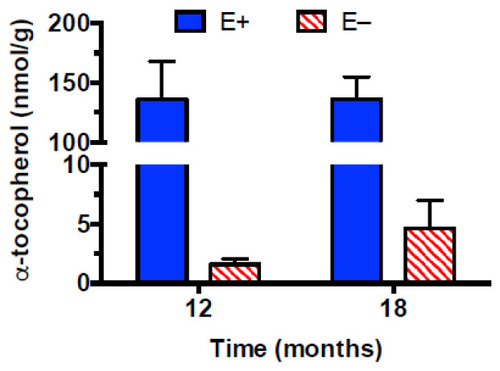- Title
-
Chronic Vitamin E Deficiency Dysregulates Purine, Phospholipid, and Amino Acid Metabolism in Aging Zebrafish Skeletal Muscle
- Authors
- Henderson, T.D., Choi, J., Leonard, S.W., Head, B., Tanguay, R.L., Barton, C.L., Traber, M.G.
- Source
- Full text @ Antioxidants (Basel)
|
Muscle α-tocopherol concentrations. Zebrafish from the same cohort were fed a vitamin E-sufficient (E+, blue bars, n = 5 per group) or -deficient (E−, red striped bars, n = 5 at 12 months and n = 4 at 18 months) diet from age 45 days until 12 or 18 months. At the indicated times, fish were sacrificed, the muscles harvested, frozen, and kept frozen until analysis. α-Tocopherol skeletal muscle concentrations (mean ± SD) show a diet main effect ( |
|
Analysis of E+ fish muscles at 12 vs. 18 months. The heatmap ( |
|
Metabolomic differences between E+ and E− fish muscles at 12 months. Shown are the heatmap ( |
|
Metabolomic differences between E+ and E− fish muscles at 18 months. Shown are the heatmap ( |
|
Purine metabolism is altered in E− zebrafish muscle at 18 months. Bar graphs showing Student’s |
|
Metabolomic differences between E− fish at 12 and 18 months. Shown are the heatmap ( |






